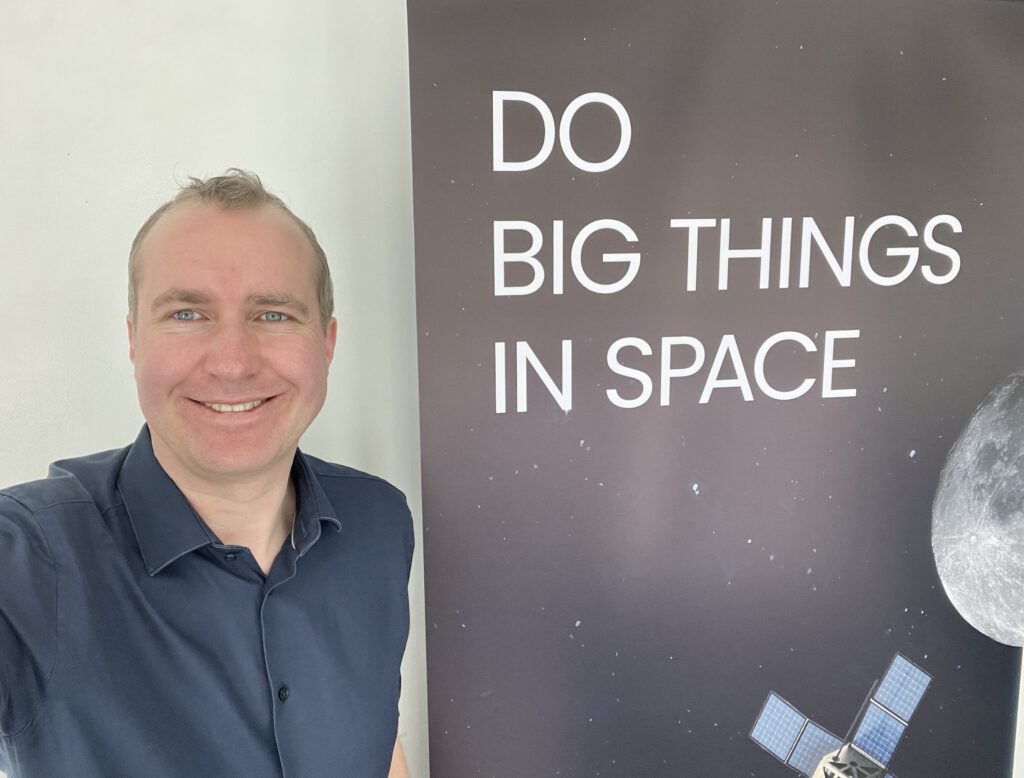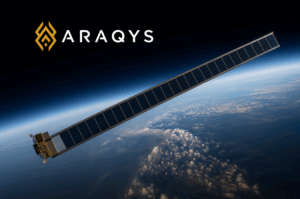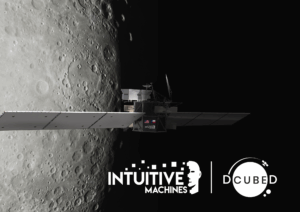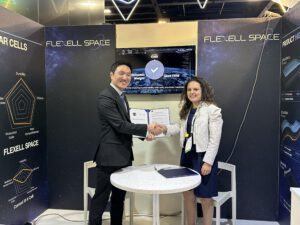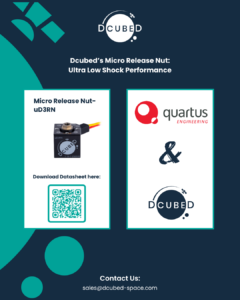Our Marketing Team had the opportunity to sit down with Thomas, the CEO of DCUBED. In this discussion, we delved into the exciting world of space mechanisms and the remarkable journey undertaken by DCUBED. Thomas shared his perspective on the company’s vision to do big things in space, enabling customers to achieve greatness while pushing the boundaries of what was possible. From their early focus on developing cutting-edge release actuators to their venture into deployables and in-space, DCUBED was poised to revolutionize the industry. We explored Thomas’ leadership style, the intersection of work and family, and what set DCUBED apart as one of the best places to work.
Q: Hi, Thomas! My first question is, when did your passion for space begin?
Thomas: Well, my passion for space actually started when I was a little boy. I grew up near Lampoldshausen, which is very close to Stuttgart. That’s where the rocket test center of the European space industry is located. When I was growing up, I could see the smoke coming out of the forest and the windows would shake. So for me, it was always about space. I thought it was so cool to have so much power and to go to space, especially interstellar travel. The technology behind it fascinated me.
Q: That’s amazing! So, as a kid who was inspired by space, what did you do next?
Thomas: Well, of course, I started buying all the Lego sets related to rockets and spaceships. Actually, my family bought them for me. I had a whole fleet of spacecraft. Then I got into model building and discovered model rocketry. However, I was quite young and wasn’t sure if my parents would approve of me handling explosives. So I secretly bought model rockets and propulsion units and hid them in my room. Whenever there was nobody watching, I would go to the field behind our house and launch them. The nice thing about those rockets was that you attach the propulsion unit, it goes up, and when it reaches the peak, a parachute opens, and it floats back down. I also started building my own rocket engines using baking powder and flour, but they didn’t work out so well. I even tried building my own rockets on New Year’s Eve, but they were always big failures. Space was my obsession during childhood.
Then, when I went to high school, I didn’t think you could study space engineering. I thought I would focus on mathematics and physics and go to university for either of those subjects. However, there was a trial day at the University of Stuttgart where I explored mathematics, physics, and even a bit of food chemistry, but they didn’t excite me. That’s when I discovered that there was a dedicated course for space engineering. I couldn’t believe it! I wondered why everyone wasn’t studying space engineering because it seemed like the coolest thing. You get to build spacecraft, explore planets, and create robots. So, I decided to give it a shot and applied for space engineering as my first choice, and mathematics and physics as my second and third choices. Luckily, I got accepted into the Space Engineering Institute in Stuttgart and in Munich, and I ultimately chose Stuttgart.
Q: That’s a fantastic journey, Thomas! It’s great to see how your childhood fascination with space led you to pursue your dreams. So, why did you decide on Stuttgart? Was it because it was closer to home?
Thomas: Well, the main reason was that I wanted to get away from home. You can imagine that a rocket engine testing site doesn’t have much around it. You need a lot of forests and open space. I wanted to go to a bigger city, and Stuttgart was already a big city. The reason I chose Stuttgart over Munich was because, at that time in 2003, Stuttgart had a full aerospace course. In Munich, it was focused more on mechanical engineering with a specialization in space engineering. Additionally, back then, there was a diploma system where you had to study for seven or eight years. I thought I could start directly working on spacecraft, but I was mistaken. It turned out to be regular mechanical engineering for the first few years, although we did design components for space shuttles and airplanes. It was frustrating, and I felt it was progressing too slowly in Stuttgart. I had already studied there for three and a half years and realized that if I wanted to complete the degree, I would have to stay for another four years. That’s when I thought about going abroad because my English wasn’t very good, and I felt I needed to improve it. I applied to study in America and got accepted at the University of Kansas, which is located in the middle of the U.S. I figured if any invasion happened from any direction, Kansas would be the safest place to be.
At the University of Kansas, I had a professor who had a lab called the Adaptive Structures Lab. He allowed all the students to work with shape memory alloys, piezoelectrics, and other smart materials. We could go in and build whatever we wanted. I became passionate about shape memory alloys and started building actuators. However, there wasn’t much space-related activity in Kansas, although they did have a museum with some recovered engines from the sea. I have no idea why in the middle of America they are experts in saltwater recovery.
Q: Interesting! So, what happened between your time in Kansas and DCUBED?
Thomas: Yeah, so there I was working on an adaptive airfoil using shape memory alloy. It was fascinating to see what you could do with this material. You could train it into different shapes and it would always return to its original form. Once I finished my master’s degree in this field, I saw many of my friends joining companies like SpaceX and Blue Origin, which were doing incredible things in the new space industry. I also tried to get into those companies, but as a German fresh out of university, I didn’t have much chance. So I didn’t want to go back to Germany just yet. Instead, I went to Scotland to pursue a Ph.D. in deployable space structures. My professor’s research group focused on asteroid deflection and saving the Earth from potential hazards. We wanted to explore the idea of using a large structure to concentrate the sun’s energy on an asteroid, causing it to slowly move away. This required a substantial structure that could change shape. During my Ph.D., I had the opportunity to fly experiments on sounding rockets and a stratospheric balloon. I also started collaborating with NASA on space solar power, which aimed to bring energy from space to solve the energy crisis on Earth. It was a far-fetched project, but it had significant potential. After completing my Ph.D., I decided to join the European Space Agency (ESA) with the expectation of working on satellites and space robots. However, I quickly realized that my role mostly involved reviewing industry documentation as ESA outsourced most of its projects to industry partners. While it wasn’t as innovative as I had hoped, it did allow me to establish a valuable network. I began to question where true innovation occurred, and I discovered it was in the industry. So, I moved to Munich and joined an SME (small and medium-sized enterprise) focused on building deployable structures such as antennas and drag sails. I became the project manager and section head of the deployable drag sail section. I spent five years there, primarily working on contracts from ESA and the European Commission, always staying within Europe. However, a friend of mine started working at Rocket Lab, a company that had recently launched two rockets and was seeking payloads for an upcoming mission. They had a last-minute spot available, and if I could get our hardware ready to test in New Zealand within three months, we could secure the launch. I was already working on a side project involving a deployable drag sail for a CubeSat. However, finding a suitable release mechanism within the tight timeframe proved challenging. Frustrated, I conducted extensive research, used all my holidays, and even bought a 3D printer to develop the release actuator myself. This experience fueled my determination, as I realized the market lacked readily available solutions. Another frustration was the slow pace of the European space industry.
Q: I’ve heard many stories like where founders go out and actively seek problems to solve. But in your case, the problem was right in front of you, and it was a significant one.
Thomas: Absolutely, yeah. Interestingly, my brother was also an entrepreneur before me, and I used to wonder why someone would want to have their own company. I mean, why not just have a regular nine-to-five job with weekends, holidays, and free time? I couldn’t understand it. But after working for a while, I grew frustrated with how things were done, and I felt unheard. That’s when I realized that having your own company means taking responsibility for your actions, but it also opens up a world of possibilities and fun.
Q: It seems like you’re having a great time most of the time.
Thomas: Yes, I wouldn’t go back.
Q: Okay, moving on to my next question. What was one significant challenge that DCUBED faced and overcame in recent years?
Thomas: One of the biggest challenges has always been growing the business, acquiring new customers and projects, which, in turn, requires hiring new people. As the team grows, we faced the challenge of figuring out the best approach to tackle these projects and determining who to hire to strengthen our team. Luckily, we’ve been fortunate enough to find the right people so far. DCUBED is really about the incredible things our people can achieve. Sometimes, when I walk into the lab and see the tests being conducted on deployable solar arrays or the serial production setup of the release actuators, I can’t believe it. These small devices will soon be going to the moon, Mars, and even on almost every SpaceX rocket now.
Q: It’s truly amazing. This leads me to my next question. What has been your proudest moment at DCUBED?
Thomas: I think our proudest moment was last year in January. It was our first space flight on the SpaceX transporter. We had been working on this for the past two and a half years, aiming to get our product into space. The challenge with space is that if you haven’t been there before, it’s challenging to get your product considered for a space mission. But we did it. Originally, it was intended as a demonstration mission where we wanted to test some actuators. However, a customer urgently needed our product, and they trusted us to deploy their six satellites. So it became our In-Orbit Demonstration (IOD) mission and our first customer mission, all in one. I remember feeling nervous right before the launch, thinking that it might be canceled or delayed. But we had conducted numerous tests on the ground to ensure everything would work flawlessly. The entire team gathered at a brewery we had rented out, watching the live stream as the rocket lifted off the ground. It was an intense and focused atmosphere. Seeing the rocket soar into space, knowing that we had held that very product in our hands just weeks before, was an incredible feeling. An hour later, our deployment began, and when SpaceX announced the success of the first deployment, everyone was in tears of joy. The celebration continued throughout the night. That moment was our proudest because it marked our first venture into space. However, I must say that with every subsequent space flight, and we’ve had four since then, the excitement remains. We have another one coming up in a month, and I’m always eagerly looking forward to it. Watching rocket launches and being involved in space activities is truly a thrilling experience.
Q: So the excitement never fades.
Thomas: Not for me, at least.
Q: Alright. So you recently revised your vision to do big things in space. Can you elaborate on what that entails?
Thomas: Absolutely. While we recently unveiled our new vision, it has always been at the core of our aspirations since the inception of the company. From the very beginning, I entered the space industry with the intention of making significant contributions, rather than merely being a supplier for others’ projects. We wanted to empower our customers to accomplish remarkable feats, while simultaneously striving to achieve greatness as a company.
In the past few years, our primary focus was on developing and bringing our existing products to market, rather than heavily promoting this broader vision. However, now is the opportune moment, as we stand on the threshold of investing more in research and development for future products. Our journey began with release actuators and progressed to deployables, such as solar arrays, reflector arrays, and radiators. And now, we are entering the next phase—exploring how we can even bigger things in space.
Our vision to do big things encompasses in-space manufacturing and assembly, where we leverage the capability to construct structures directly in space using highly flexible deployable components. This approach eliminates the need for excessive mechanisms and constraints required to fit structures within rockets for launch. By directly building in space, we can revolutionize the industry with a disruptive technology that enables the creation of immense structures.
Therefore, our new vision to do big things in space encapsulates our true intentions and serves as a memorable rallying point for everyone involved. We are committed to pursuing ambitious goals as a company while empowering our customers and partners to think boldly in the realm of space.
Q: Could you share your vision for DCUBED in five years?
Thomas: In the next five years, we aim to become the primary partner for all space mechanisms. Whenever someone thinks about a large structure that needs to be small during launch, they should immediately consider DCUBED. Our roadmap encompasses the release actuators as the initial step, ensuring safe entry into space. Then we focus on deployables, enabling significant presence and functionality in space. Additionally, we are venturing into in-space manufacturing, where we construct larger structures directly in space, contributing to the growth of the space economy.
One exciting initiative we’re pursuing is introducing e-commerce to the space industry. Currently, space devices are typically designed upon receiving a purchase order or starting a project. However, we are embracing commercially available off-the-shelf components that can be easily purchased. With our deployables, we are moving towards a mass-customizable approach, leveraging modular solar arrays that can be tailored to the customer’s requirements. The next step is to allow customers to order directly from our website using their credit cards, eliminating the need for salesperson involvement. Engineers can simply select the desired products, make a purchase, and receive release actuators or deployables within a few weeks.
Q: As an engineer, I can attest to the convenience of such a system. Now, let’s shift the focus to your leadership style. How would you describe it, and are there any distinct characteristics you actively employ as a leader?
Thomas: I believe in having a strong team with individuals who already possess the knowledge and skills required for their respective roles. My leadership style revolves around providing a general direction for the company and then empowering the team members to implement their ideas and solutions. While I might have my own notions on how things should be done, I acknowledge that others’ perspectives may offer more efficient or innovative approaches. By allowing multiple team members to contribute and execute their ideas, we can achieve greatness as a company. Therefore, I offer guidance and steering when necessary, while granting considerable freedom to explore and experiment with different approaches.
Q: That makes a lot of sense and sounds empowering for the team. Now, how do you manage the responsibilities of leading a growing company while balancing family life with kids and cats?
Thomas: Initially, when we started the company, we were part of the accelerator program at the Munich University of Applied Sciences. However, due to the COVID-19 pandemic, we had to leave the program and move into a house. I set up the company in the basement, and my family, including our two cats, joined me. The cats were always eager to get into the basement, which posed some challenges as their fur would end up in unexpected places, including our food. It took us a while to resolve the issue and ensure a clean working environment.
Despite these early challenges, the current setup works well. I have the flexibility to divide my time between working from home and the office, as I live close by. This flexibility allows me to effectively manage my responsibilities both at work and with my family. I can adjust my schedule according to the needs of the company and enjoy quality time with my family when required. It’s a mutually beneficial arrangement.
Q: Flexibility seems to be a key aspect, and it’s great that it works well for both your professional and personal life. Now, speaking of DCUBED as a workplace, what do you think makes it one of the best places to work? What is the most rewarding aspect for you and the team?
Thomas: The most rewarding aspect of working at DCUBED is the close connection we have with space. We are involved in developing and manufacturing hardware that can be deployed in various missions, from low Earth orbit to geostationary orbit and even the Moon. The idea that our products, which we held in our hands just a few weeks prior, will soon be on the surface of the Moon is mind-boggling. Celebrating these achievements together as a team, watching rocket launches, and having a space bar where we can gather to watch launches are all incredible perks.
Furthermore, our work is not limited to a single mission but extends to every satellite and rocket that requires our products. This continuous flow of projects keeps the excitement alive, and I don’t foresee it becoming monotonous. On top of the technical aspects, the team dynamics are fantastic. Coming to DCUBED each morning should be an enjoyable experience, and I love engaging with the team members to learn about their current projects. Stepping into the lab and witnessing the meticulous work being done, such as testing thousands of release actuators, fills me with a sense of pride. DCUBED is where we turn the possibilities of space into reality, and it’s an amazing place to work.
Q: That wraps up all my questions, but I have a bonus question for you. With the Munich New Space Summit approaching, what are your thoughts on the future of the space industry in Germany?
Thomas: The future of the space industry in Germany is an excellent question. As our focus primarily lies outside of Germany, most of our customers are from the United States. We observe that the new space movement in the United States, characterized by the development of large constellations and space infrastructure, is progressing at a rapid pace. The availability of venture capital and a greater number of people actively involved in the industry contribute to this acceleration. In Europe, we see a gradual increase in momentum, with leaders emerging from countries like Great Britain, followed by France. Germany needs to catch up and move faster. Currently, it appears that we are still overly focused on the traditional approach, where the German Space Agency manages projects on behalf of the European Space Agency and subsequently passes them on to the industry.
For new space companies aiming to build constellations, having an anchor customer is crucial. So far, there hasn’t been a significant establishment of such customers in Germany or Europe. Even when we consider initiatives like the Iris constellation for providing internet from space, they recently announced their selection of a consortium consisting of Airbus and Thales, the more traditional space companies. They are attempting to run a commercial business on a government scale. It remains to be seen if this approach will be successful. As a proud German, I have high hopes that the situation will improve, but we also need to see tangible results.
Q: It sounds like an incredibly inspiring and rewarding environment. Thank you for sharing your insights, Thomas.
Thomas: Absolutely! Our vision is to accomplish significant feats in space. We are actively seeking to expand our team with brilliant minds and collaborate with companies and institutes worldwide to help them realize their ambitious space endeavors. It may sound a bit cheesy, but we genuinely believe in making big dreams in space a reality.
